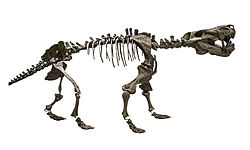
Back إنوسترانسيفيا Arabic Иностранцевии Bulgarian Inostrancevia Catalan Inostrancevia Czech Inostrancevia German Ινοστρανσέβια Greek Inostrancevia Spanish اینوسترانسویا Persian Inostrancevia Finnish Inostrancevia French
| Inostrancevia | |
|---|---|

| |
| Mounted skeleton of I. alexandri (PIN 1758), exposed at the Museo delle Scienze, Trento, Italy | |
| Scientific classification | |
| Domain: | Eukaryota |
| Kingdom: | Animalia |
| Phylum: | Chordata |
| Clade: | Synapsida |
| Clade: | Therapsida |
| Clade: | †Gorgonopsia |
| Family: | †Gorgonopsidae |
| Subfamily: | †Inostranceviinae |
| Genus: | †Inostrancevia Amalitsky, 1922 |
| Type species | |
| †Inostrancevia alexandri Amalitsky, 1922
| |
| Other species | |
| Synonyms | |
|
List of synonyms
| |
Inostrancevia is an extinct genus of large carnivorous therapsids which lived during the Late Permian in what are now Siberia, Russia and Southern Africa. The first-known fossils of this gorgonopsian were discovered in the Northern Dvina, where two almost complete skeletons were exhumed. Subsequently, several other fossil materials were discovered in various oblasts, and these finds will lead to a confusion about the exact number of valid species in the country, before only three of them were officially recognized: I. alexandri, I. latifrons and I. uralensis. More recent research carried out in South Africa has discovered fairly well-preserved remains of the genus, being attributed to the species I. africana. An isolated left premaxilla suggests that Inostrancevia also lived in Tanzania during the earliest Lopingian age. The whole genus is named in honor of Alexander Inostrantsev, professor of Vladimir P. Amalitsky, the paleontologist who described the taxon.
Inostrancevia is the biggest-known gorgonopsian, the largest fossil specimens indicating an estimated size between 3 m (9.8 ft) and 3.5 m (11 ft) long. The animal is characterized by its robust skeleton, broad skull and a very advanced dentition, possessing large canines, the longest of which can reach 15 cm (5.9 in) and probably used to shear the skin off its prey. Like most other gorgonopsians, Inostrancevia had a particularly large jaw opening angle, which would have allowed to deliver fatal bites.
First regularly classified as close to African taxa such as Gorgonops or rubidgeines, phylogenetic analyses published since 2018 consider it to belong to a group of derived Russian gorgonopsians, now being classified alongside the genera Suchogorgon, Sauroctonus and Pravoslavlevia. According to the Russian and South African fossil records, the faunas where Inostrancevia is recorded were fluvial ecosystems containing many tetrapods, where it turns out to have been the main predator.
- ^ Cite error: The named reference
Kukhtinovetal2008was invoked but never defined (see the help page). - ^ Kammerer, Christian F.; Viglietti, Pia A.; Butler, Elize; Botha, Jennifer (2022). "Rapid turnover of top predators in African terrestrial faunas around the Permian-Triassic mass extinction". Current Biology. 33 (11): 2283–2290. doi:10.1016/j.cub.2023.04.007. PMID 37220743. S2CID 258835757.
© MMXXIII Rich X Search. We shall prevail. All rights reserved. Rich X Search